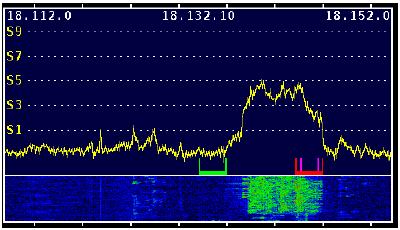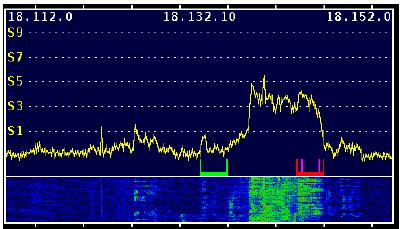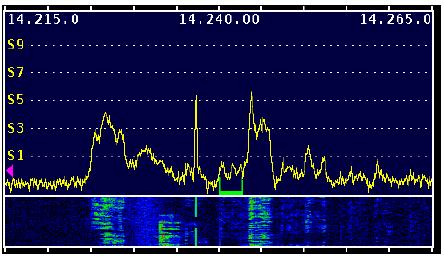K5LAD - 50+ Years of Ham Radio Memories
Volume XXXVIII
Working DX With the Panadapter
By Jim Pickett – K5LAD
Search keywords: Elecraft panadapter, P3, DXpedition
Have you ever been listening to a DX station or, perhaps,
a DXpedition and wonder what it would be like to experience this? The excitement of visiting a foreign country and
being a station that hams all over the world sought to contact. You could be so selective and work just the
stations you want and in whatever order you wanted to work them………….
Right?………….. yeah, sure. If
you’re the DX station, there are hundreds or thousands of stations calling you and
you’re supposed to pick them out, one by one, and give them a report. Some of us call CQ from our home station and have
a real problem picking out a single call from the one or two who might be returning our
call. Now, multiply that by a zillion and you
have some idea of what fun that DX station is having.
On top of that, if it’s a DXpedition he has probably
traded his vacation time with his family to make the trip, paid a large amount of his own
money just to be able to participate, and perhaps even brought his own equipment to be
tossed around by the airline baggage handlers and subjected to more abuse in a few days
than it might see in a decade. All of that so
he can be abused on the air by people who think he’s avoiding them for some reason. Sure sounds like fun to
me…………. how ‘bout you?
Still, many hams participate in this “fun” year
after year and still anticipate the next exotic trip with their radios as they go to
‘far away places with strange-sounding names.’
After they return home, they get to be abused by the hams who swear that
they worked him and demand a QSL card, even though that station is obviously not in their
log.
I recently had the opportunity to work a DXpedition in
the Republic of the Congo on 17 meters. The
date was January 24, 2012, the station was TN2T and it was just after a large CME (coronal mass ejection) had hit the earth and
many were wondering whether it would make propagation useless for the coming several hours
or days.
I was using my home station, which consisted of an
Elecraft K3 transceiver with the matching P3 panadapter.
For those unfamiliar with a panadapter, this is an electronic device that
looks at a broad range of frequencies in the receiver.
When you’re listening, you want to hear whatever is within a very
narrow window, which allows only the desired station to pass and to exclude all others
close by and on the band. On the other hand,
it is desirable to be able to see a much wider window to know how many stations are
transmitting and how many are available on what you might have first thought to be, dead
band.
The span of viewable frequencies is adjustable on the P3
from as much as 200 KHz to as small as 2 KHz. Markers
display on a horizontal line which represents the “window” you’re viewing,
i.e., if the span is set to 82 KHz, every signal your receiver is detecting within the 82
KHz total, counting both sides of your listening frequency, will be a vertical blip and
the height of the blip represents the signal strength.
The stronger the signal received, the taller the blip. Note that on the P3 the vertical range is also
adjustable. The P3 also allows the user to
freeze the screen and make a print of what was being displayed at the moment of the
freeze. The following is an example of one of
these picture files:
Note: The
SCAN setup on the right was 50 KHz (14.215-14.265) and the receiver was actually listening
to a station transmitting on 14.240 KHz. The
yellow horizontal jagged line is the noise floor and anything above it is some sort of
signal and may be a phone signal or a tune up or CW signal. |
|
|
This picture was made on Jan. 24, 2012 with my K3 VFO
sitting on 14.240 KHz. where I was listening. It
was about 3:30 PM and the P3 scan was set to 50 KHz so the “window” was looking
at all the signals within the range of 14.215 and 14.265 KHz. The green half-square on the base line shows the
width of the roofing filter I had employed at that time which was 2.8 KHz. The indication of the station I was listening to
was within that green half-box. He was not
particular strong but was Q5 copy. You can
see another signal just to the right of the green box and the height of the blip shows
that he was quite strong. The nice thing
about the K3 and its roofing filters is, they are so tight that I was unable to hear that
station displayed on the right. The roofing
filter also is so tight that the AGC (automatic gain control) in the K3’s receiver
was unaffected (no pumping from a close-by signal) and if I had not seen the blip I would
never have known he was there.
You can see several other signals within the window both
above and below where I was actually listening. The
very narrow blip that is just to the left of the center is not being modulated since it is
very narrow. It was probably a station tuning
up their transmitter or perhaps their amplifier. The
waterfall on the bottom of the display shows what had been heard just milliseconds before. Note that the tune up signal had been
on-off-on.
Meanwhile, back to the story about DXing. Again, I had the opportunity to work a DXpedition that was in the Republic of the Congo and on 17 meters at the time. The date was January 24, 2012 and the station was TN2T. Note in the print here, I was tuned to 18.132.1 KHz listening to the DX station. He was operating split and would announce that he was “listening up 5 to 10.” There seemed to be jillions of stations calling him. I had my station configured where the DX station was in the left ear of my headphones and the other receiver (which was being tuned up and down from 18.137 to 18.143) was in the right ear. I became absolutely fascinated by the panadapter patterns and I’ll describe what I was seeing.

When the DX station announced he was listening, all
stations started transmitting within that 5 KHz window where he said he was listening. Often, when working DX stations on split I can see
small null space where no stations, or only a few stations, are calling and I can set my
transmitter to that spot. In this case, there
were zero spaces of ‘no one calling’ and the hump of the display from the right
side of the green box to the right side of the purple box was filled with hundreds of
stations calling him, perhaps even thousands.
One other explanation of the picture; the purple half-box
shows the listening window of the second receiver (the K3 has the option to add a second
receiver, which is an exact duplicate of the standard receiver. This allows several benefits over the
“dual-watch” feature of many other transceivers where a second VFO allows
listening on one or the other frequency but not both simultaneously like is possible on
the K3.) When the transceiver is set to
“split” this is also where I will actually transmit when I key the
transmitter.
The red half-box around the purple half-box tells me that
my transceiver is set on “split” so I don’t accidentally transmit on the DX
station’s frequency. My second receiver
(purple box and the frequency where I would be transmitting) was sitting right on 18.142.1
KHz so you can get an idea of the frequencies you’re seeing in the display. There’s nothing special about where I chose
to transmit to him. It just happened to be
exactly 10 KHz above his frequency.

I made several screen prints of the P3 display so you can
see the callers thick and heavy, and all calling the DX station. This picture shows some red in the water-fall. Just like the TV weather maps, the red denotes
that it’s stronger (signals) than just the green marks. |
|
|
|
|
|
|
|
Here you see the DX station is transmitting (above the green box), the window to the right shows few signals since most are not transmitting. Just to the right of the DX station are a couple of tuner-uppers designated by the narrow blips. |
||
|
|
|
||
|
|
Here you see stations tuning up on the DX station’s
frequency. If you happened to be listening at
this time you would hear numerous grown men acting like little children, yelling
profanities and other inconsiderate things to the stations who may or may not have been
aware that their transmissions were in the wrong place. |
||
|
|
Another good look at the myriad of stations calling the DX
station while he attempts to pick a single call out of the mess. Remember, too, that this “hump” of
stations consists of stations running QRP, 100 watts, and various sizes of amplifiers. All want the DX stations to hear only them and
wish all the other callers would go watch TV or cut their lawn. |
|
|
Finally I got over my fascination of watching the panadapter and worked TN2T in the Congo at 3:12 PM. While I am transmitting, the P3 freezes the screen so I cannot display the screen during this time. |
-- written January
24, 2012
Page visited 566 times![]() Return to the Home Page
Return to the Home Page







